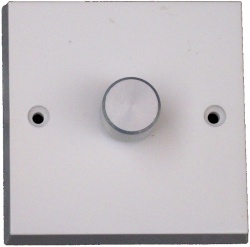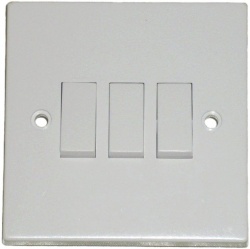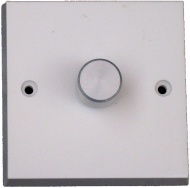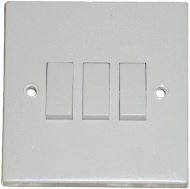Dimmers & Switchbanks
Dimmers & Switchbanks are both ways to control lighting levels, improving both utility and comfort.
This article sets out the advantages of controlled lighting levels, and looks at the relative merits of different ways of achieving them. Some installation notes are also included.
Advantages of Lighting Level Control
Controllable lighting brightness permits
- Relaxed lighting in the evening
- Bright lighting when its needed for a task
- Improved safety by allowing low light levels to be used at night; particularly advantageous if small children are about.
- Better comfort and better visibility.
- Can often reduce energy use, but doesn't always
Methods of Lighting Level Control
Dimmer & filament lamp
A Dimmer is an electronic control that reduces the power flowing through the lamps it controls, which in turn causes a continuously variable change in brightness to be achieved.
The reduction in brightness is not matched in proportion with a reduction in energy consumption, since a good proportion of the energy requirement for a filament lamp is just getting it hot enough to begin to glow. Measurement of a dimmed halogen lamp showed 60% rated power consumption at apx 8% light output.
Dimmers don't require any overlap in lighting areas to achieve their effect.
Compatibility
Standard dimmers have restrictions on the types of lights they will run.
- Fully compatible with mains filament bulbs
- Fully compatible with mains halogens.
- Compatible with most electronic 12V halogen lighting transformers, but not all.
- Not compatible with toroidal halogen lighting transformers.
- Not compatible with almost all CFLs
- Not compatible with linear fluorescent
- Not compatible with discharge lighting (HID, sodium, mercury)
Dimmable fluorescent lighting ballasts are available. When used the dimmer & ballast chosen must be compatible with each other.
Special dimmable CFLs are available, but are relatively high priced and little used.
Reliability
Dimmers aren't as reliable as switches, and failures do occur occasionally. 250w dimmers are rather less robust on the whole than 500w dimmers. A dimmer is also a single failure point, meaning a failure can cause whole room lighting failure.
Filament bulbs occasionally consume a heavy current surge on failure, due to arc-over. Such a current surge has a high chance of destroying a dimmer. These surges are more likely to occur and be of higher currents with
- small form factor mains filament bulbs (especially mains halogen)
- short cable runs.
12v bulbs and non-filament type lamps don't suffer from this.
Specifying a 500w dimmer with well below 500w of lighting load improves reliability some. Dimmers should not be loaded past their max rating, this elevates failure rate greatly.
Wiring Arrangements
A dimmer usually replaces an existing switch, with no added complication.
The exception to this is when two way operation is required. If you wish to control brightness from both switch positions then a special master / slave dimmer switch will be required. Conventional dimmers will allow two way switching, but not two way brightness control.
Switchbank
A Switchbank is a bank of 2 or more switches, where each switch controls some of the lights in a room. More than one lighting level is thus achieved depending on which lights are on.
To operate well, switchbanks require lights to have overlapping lighting areas; so a long room with only two lights, one at each end, may not be an ideal candidate for a switchbank. Uneven lighting can be an issue when fitting switchbanks to an installation with a minimum number of lights, as was common practice in the 1970s and before.
When using a switchbank with multiple downlighters, there are various ways to distribute the lights among the switches. Groups of lights on each switch and alternate lights on each switch are both popular options. What works best depends on the room and lighting layout.
2 or 3 switches is enough for most people. More switches make for more possible lighting patterns or levels if desired.
Compatibility
Switchbanks are compatible with all types of lighting.
Reliability
Switchbanks are as reliable as any other light switch arrangement, ie very reliable. And if one element fails, the system as a whole still works.
If more lights are fitted at the same time, that translates to more bulb replacements. This is not generally a cost disadvantage due to greater running energy efficiency than dimmed lamps.
Installation Tips
Single sized standard light switches come with up to 3 switches, plenty for most rooms.
More Switches
Large and specialist lighting installs may require more switches. Standard double faceplates come with upto 6 switches. To get even more switches requires either a gridswitch, additional faceplates, or a custom switch assembly made from a blanking plate. The gridswitch is the usual choice, and can incorporate dimmers and indicators etc as well as switches.
Each additional switch doubles the number of available lighting patterns, hence 3 and 4 gang switchbanks are normally plenty.
- A 2 gang switch gives 3 lighting levels, if the lights are of different wattage
- A 3 gang switch gives 7 lighting patterns/levels
- A 4 gang switch gives 15 lighting combinations & levels!
Wiring Arrangements
Loop-in
Loop-in is the most common lighting circuit arrangement. Power is daisy-chained from each lighting fitting to the next, and a separate switch wire connects a switch to each fitting. This is simple and easy to implement for general lighting wiring, but is not compatible as it stands with switchbanks. To retrofit switchbanks into such a system would require additional wiring, complicating the wiring layout.
Switch loop through
The other method in use for domestic lighting is to run the power feed to the switch first rather than the lighting (so power feed to the next room is taken from the switch position and not from a light fitting). From the switch, a cable with neutral, earth & switched live is run to the lighting. A minority of house lighting is wired this way.
When more than one cable is run from the light switch to more than one light fitting, a switchbank can be retrofitted without adding any further wiring. However in most retrofit cases such wiring is not already present. Hence switchbanks are more often fitted at new installation and rewire times rather than retrofitted.
Just 1 light fitting
Occasionally its wanted to provide just one power feed at a time, not both. This may be done when 2 or more lightbulbs are in one light fitting, and:
- operating both at the same time would take the fitting over its rated power,
- or would operate filament and cfl bulbs at the same time, overheating the CFL
A pair of switches is wired to provide power to only one output. Note that this 1-only setup can equally well cover either all switches in a switchbank, or just some, as needed.
o------- switched live 1
o---------O--
Live -----O-- o------- switched live 2
o
sw1 sw2
Combined dimmer & switchbank
Another option is to combine both techniques. There are a few possible ways to do this:
- Dimmer followed by switchbank
- Multiple dimmers
- A switch for some lights, and a dimmer for the other lights
This gives some the advantages of a switchbank while retaining the continuously variable nature of the dimmer.
Compatibility
Dimmer controlled fittings only work with filament lamps, and special dimmable CFLs.
Reliability
Dimmers are less reliable than switches.
Switch dimmable CFL
CFLs are available that will select more than one brightness level, controlled by operating an ordinary lightswitch. They cost more to buy, but save energy and run cost compared to dimmed filament lamps, much more so than compared to full brightness filament lamps.
Compatibility
As only the bulb is changed to get this feature, the fitting remains compatible with all lighting types. These CFLs aren't compatible with dimmers.
Reliability
The fixed wiring isn't altered from standard.
Boost & dim
An 18v transformer can be used to provide 3 settings of boost, normal and dim for filament lamps. The result is significantly better energy efficiency that just a dimmer. The transformer is wired to give 222v, 240v or 258v.
Its also possible to implement 2 brightness settings by using a bridge rectifier and capacitor, to give normal and boosted rms voltage.
Full discussion: Bulb Boosting & Switchable Boost
Compatibility
Compatibility depends on the method chosen. See Compatibility
Reliability
Very reliable, as long as the transformer has a thermal cutout.
Dimmable fluorescent
A dimmable fluorescent ballast enables dimming fluorescent tubes over a wide range. A dimmer control compatible with the ballast must be used. The result is a fraction of the energy consumption of filament lamps at full power, and the ratio improves a lot further as the tube is dimmed, as fluorescent efficiency falls a little when dimmed, filament lamp efficieny falls a lot.
How to make a fluorescent fitting unseen How to ensure good light quality
Fitting
Dimmer
Dimmers just replace a lightswitch in an existing installation, with no need for any extra wiring to be installed. Retrofitting is easy, and the cost minimal.
Switchbank
If 2 or more light fittings have their own cables running to the switch, then a switchbank can be fitted very easily. Its just a case of replacing the old switch.
But more often there are no separate cables, and extra cable needs to be run to retrofit a switchbank. This heavily limits their retrofit use in practice.
Retrofit cost is trivial in the first case, but requires channelling for new cable in the 2nd case.
The extra cost of fitting a switchbank when building new is trivial, and usually paid back many times over in the life of the installation by reduced electricity use.
A switchbank can also be used to mix or choose between filament and other lighting. One example of this would be concealed fluorescent uplighting with halogen spots for task and feature lighting.
Switch dimmable CFL
Just plug it in. Can be used anywhere except on a dimmer.
Boost & dim
The light switch is replaced with a switchbank. A fused 18v transformer with thermal cutout is fitted in a suitable cavity. No wiring needs replacing. There's more than one way to set up the switching, and all options require the right type of switches. The transformer goes near switch or light fitting, whichever has a neutral connection.
Dimmable fluorescent
The Incandescent Lightbulb Ban
Traditional domestic incandescent-filament light bulbs are no longer allowed to be sold within the EU, for reasons of efficiency. "Industrial" incandescent-filament light bulbs are commonly available; but they give significantly less light for the same rated power. Both sorts should now be used only in places where they are rarely lit.
In ordinary switched circuits, incandescent bulbs should otherwise be replaced with CFL "bulbs", or, better, with LED lighting.
In dimmer-controlled circuits, the type of dimmer must match the type of lamp - and there should be some sort of labelling to indicate the situation to whoever may replace dimmer or bulbs.
John Stockton (talk) 15:55, 6 February 2017 (UTC)
Bulb Life
Switchbanks have no effect on lamp life.
Dimmers usually soft start lamps. This extends mains halogen lamp life to some extent, but makes insignificant difference with all other types of lamp.
Switch dimmed cfls and dimmed linear fluorescent tubes last far longer than filament lamps. Dimming them has little effect on lamp life. Linear fluorescent tubes on electronic ballasts see around 20,000 hour life average, the longest of them all.
Boost dimming reduces filament lamp life when on max setting, but the saving on electicity consumption normally outweighs added relamping cost.
Energy Efficiency & Running Cost
Dimmers
While it is often assumed that fitting a dimmer will reduce energy use, the reality is more complex. In some cases energy is saved, in some cases energy use increases. See this discussion for explanation and detail.
If frequently using less than maximum brightness illumination, the energy saving potential of a switchbank is much greater.
For users who rarely use less than maximum brightness illumination, no option saves significant energy or cost.
Switchbanks
All lighting on a switchbank runs at full energy efficiency, hence switchbanks are an inherently more energy efficient option than dimmers.
Switchbanks are also compatible with all lighting types, whereas dimmers only work with the higher energy consumption types of lighting (tungsten filament & halogen). Energy efficiency and compatibility are the main advantages of switchbank over dimmer.
Examples
Run cost and energy use depend on what amount and type of lighting is used at what setting for how long, so is a very variable figure.
This section will compare lighting energy use for a hypothetical room that is equipped with 300W of filament lighting or the approximate equivalent of 100W of CFL lighting. For this example we will use a daily use pattern of:
- 1 hour a day of 40w filament equivalent output
- 5 hours a day of 150w filament equivalent output
- 1 hour a day of 300w filament equivalent output (i.e. full brightness)
Prices are given for 10p/unit electricity cost.
No Control
Firstly the no control option, for which we will like most typical householders, have to select the wattage best suited to all round use, in this case 150w since that is the most common lighting level required. This is a compromise since we cant have the levels we really want some of the time, so comfort and utility are not optimal.
7 hours at 150W = 1.05kWh / day = £38 pa = £960 per 25 yr installation life.
If we really must have the full brightness option, then obviously the costs above will double. A more realistic option might be to provide additional table lights etc and keep the main lighting at a more conservative level.
If we opted for 50w of CFL instead:
7 hours at 50W = 0.35kWh / day = £13 pa = £319 per 25 yr installation life.
Switchbank
A total of 300W of filament lamps on switchbank will use: 1 hour at 40w = 0.04kwh + 5 hours at 150w = 0.75kwh + 1 hour at 300w = 0.2kwh
Total usage = 0.99kwh/day = £36 / year or £903 per 25 yr installation life.
CFL Lamps on switchbank will use: 0.015 + 5 x 0.8 + 0.1 kWh = 0.195kWh / day = £7 / year = £177 per 25 yr installation life.
Dimmer
For 300w of halogen on a dimmer: we will assume to get 40w equivalent brightness we run at 50% full current, and for 150w brightness we use 80% of full power
0.5 x 300 + 5 x 0.8 x 300 + 300 = 1.65kwh / day = £60 / year = £1,505 over 25 years
Energy Efficiency Summary
| Lighting and control | Total cost / year | Total cost / 25 years |
|---|---|---|
| CFL, Full Power No Control | £26 | £638 |
| CFL, Optimal Power, No Control | £13 | £319 |
| CFL, Switch Bank | £7 | £177 |
| CFLs on dimmer | n/a | n/a |
| Filament, Full Power, No Control | £76 | £1,920 |
| Filament, Full Power, Dimmer | £60 | £1,505 |
| Filament, Optimal Power, No Control | £38 | £960 |
| Filament, Switch Bank | £36 | £903 |
Notes:
- These are costs per room
- Costs per 25 yrs are at today's prices
From this comparison table several things are seen:
- The most expensive option is the use of full power lighting with no control. This also does not achieve the goal of controllable lighting levels.
- Full power lighting with a dimmer is a little cheaper, but not as cheap as using optimal bulb sizing in the first place. It does however give the greatest flexibility of control over the lighting.
- Switchbanks generally give a lower run cost than control using a dimmer, or opting for no control at all. Sometimes the cost reduction will be significant and switchbanks will pay back their extra installation cost many times over if fitted at rewire time.
Summary
- Switchbanks are a good idea for new installs, and if used in the intended way, may save many times their cost.
- Dimmers won't save as much money as a switch bank, and if lamp powers are not carefully chosen may end up costing more than a non controlled lighting system.
- Dimmers are the neat option for multi-bulb chandeliers.
- Dimmers are significantly easier and thus cheaper to retrofit than switchbanks.
- Dimmers give the greatest amount of lighting level control
- Dimmers prevent use of CFL Lamps.



